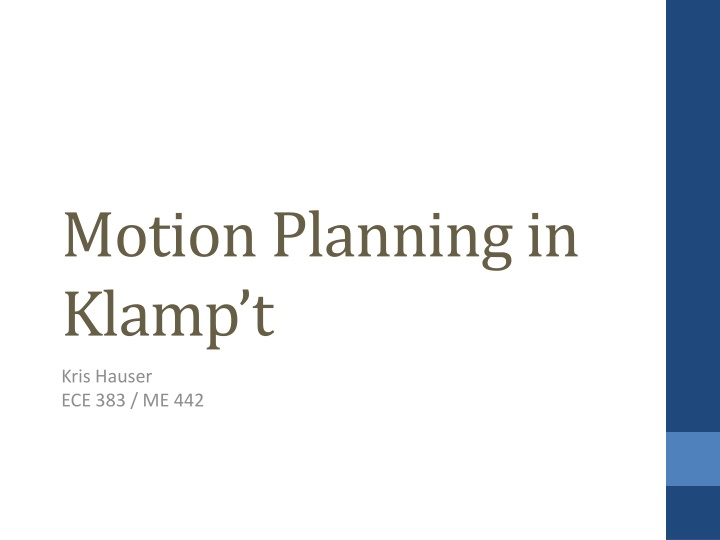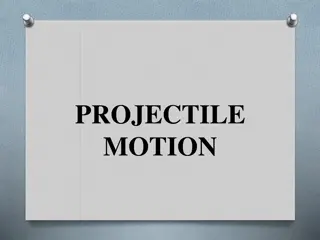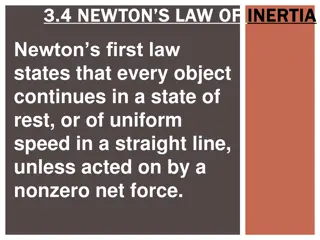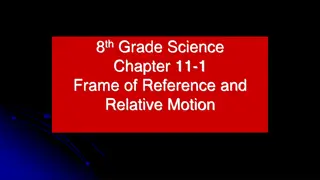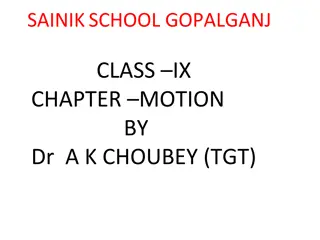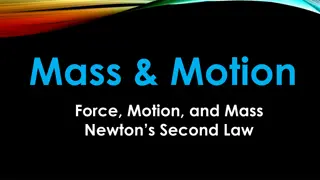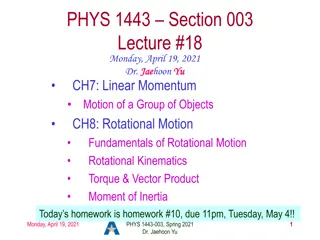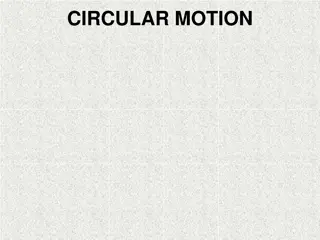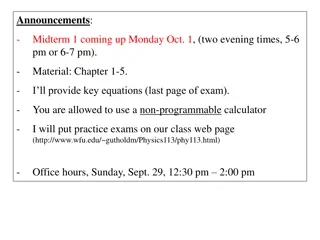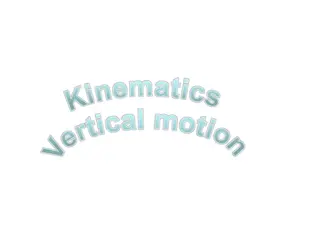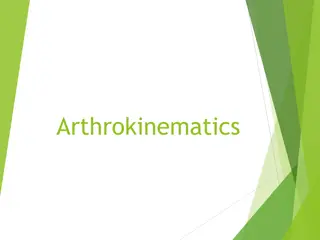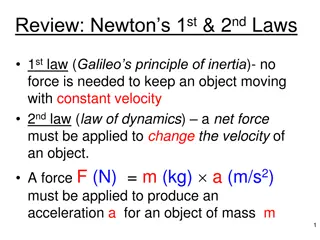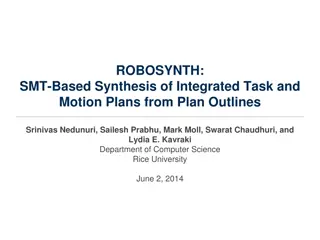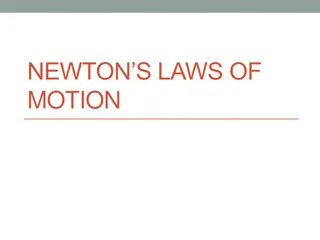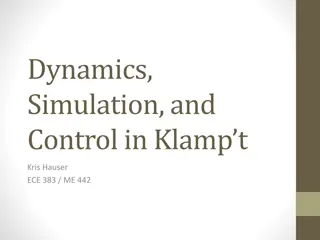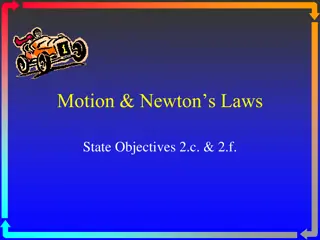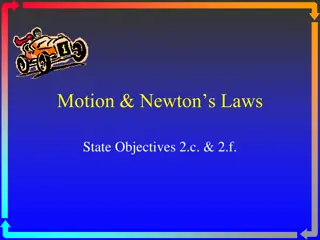Motion Planning in Klamp't: Overview and Key Concepts
Motion Planning in Klamp't covers key concepts such as C-Space and robot-level abstractions, planning algorithms, toolkit components, and the kinematic planning pipeline. It compares to other packages like OMPL, MoveIt!, and OpenRAVE, offering PRM-style planners at the C-Space level and support for common robot-level setups.
Download Presentation

Please find below an Image/Link to download the presentation.
The content on the website is provided AS IS for your information and personal use only. It may not be sold, licensed, or shared on other websites without obtaining consent from the author.If you encounter any issues during the download, it is possible that the publisher has removed the file from their server.
You are allowed to download the files provided on this website for personal or commercial use, subject to the condition that they are used lawfully. All files are the property of their respective owners.
The content on the website is provided AS IS for your information and personal use only. It may not be sold, licensed, or shared on other websites without obtaining consent from the author.
E N D
Presentation Transcript
Motion Planning in Klamp t Kris Hauser ECE 383 / ME 442
Agenda Motion planning in Klamp t Key concepts CSpace Feasibility checker (static collision checking) Visibility checker (dynamic collision checking) MotionPlan Klamp t Python API
Toolkit Components (today) Modeling Planning 3D math & geometry Paths & trajectories Inverse Kinematics Motion planning Forward Kinematics Path Trajectory optimization Dynamics smoothing Contact mechanics Physics simulation Design tools Visualization System integration Motion design Robot posing ROS JSON / Sockets interface Physics simulation Path planning Disk I/O
Context Two possible motion planning abstraction levels: C-space level (more control and generality) Input: C-obstacles and endpoints Output: a path Robot level (more convenience) Input: robot, workspace obstacles, endpoints or high-level tasks Output: a path Comparison to other packages: Open Motion Planning Library (OMPL): implements many PRM- style planning algorithms at C-space level MoveIt! and OpenRAVE: work at robot level (robot obstacle avoidance and manipulation problems, respectively) and set up C- space constraints for other planners Klamp t Implements many PRM-style planners at C-space level (& interface to OMPL) Supports some common problem setups at robot level (e.g., robot avoiding obstacles, with/without IK constraints)
Kinematic planning pipeline 1. Construct a planning problem C-space Terminal conditions (start and goal configurations, or in general, sets) 2. Instantiate a planning algorithm Take care: some algorithms work with some problems and not others 3. Call the planner Sampling-based planners are set up for use in any-time fashion Plan as long as you want in a while loop, OR Set up a termination criterion Likelihood of success increases as more time spent For optimizing planners, quality of path improves too 4. Retrieve the path (sequence of milestones)
Setting up a kinematic C-space C-Space-level interface: you must manually implement the callbacks used by the planning algorithm Feasibility tester IsFeasible?(q) Visibility tester IsVisible?(a,b) Sampling strategy q <- SampleConfig() *Perturbation sampling strategy q <- SampleNeighborhood(c,r) *Distance metric d <- Distance(a,b) *Interpolation function q <- Interpolate(a,b,u) *: default implementation assumes Cartesian space Robot-level interface: you provide a world containing a robot Standard Robot C-Space: avoids collisions Contact C-space: avoids collisions, maintains IK constraints Stance C-space: same as Contact C-space, but also enforces balance under gravity
Python API (CSpace) To set up your own problem, construct a subclass of the CSpace class whose methods will be called by the planner class MyCSpace(CSpace): def __init__(self): CSpace.__init__(self) At minimum, set up the following: bound: a list of pairs [(a1,b1), ,(an,bn)] giving an n-dimensional bounding box containing the free space eps: a visibility collision checking tolerance (more later) feasible(q): the feasibility test. Returns True if feasible, False if infeasible (OR call addFeasibilityTest(func,name=None) with as many feasibility tests as you want)
Subclassing in Python class ParentClass: def __init__(self,x): self.x = x def foo(self): print x is ,self.x def bar(self): print 2x is ,2*self.x
Subclassing in Python class ParentClass: def __init__(self,x): self.x = x def foo(self): print x is ,self.x def bar(self): print 2x is ,2*self.x class SubClass(ParentClass): def __init__(self,x,y): ParentClass.__init__(self,x+3) argument is changed self.y = y def foo(self): definition print y is ,self.y print My parent says print ParentClass.foo(self) #bar is still defined as it was before #note that the #this overridesthe parent class s foo
Python API (CSpace) more functionality visible(a,b): used for custom visibility tests sample(): returns a random configuration. Used for custom sampling distributions. Default implementation uses uniform distribution over self.bound. distance(a,b): returns a distance value between configurations a and b. Default uses Euclidean distance interpolate(a,b,u): returns a configuration u fraction of the way toward b from a. Default uses linear interpolation. sampleneighborhood(c,r): used by some planners to sample a random configuration within a neighborhood r of the configuration c. Default samples over box of width 2r intersected with self.bound
Static vs. Dynamic Collision Detection Dynamic checks Static checks
Static Feasibility Checking Override it to test whether a configuration is feasible CSpace.IsFeasible(q) (C++ API) CSpace.feasible(q) (Python API) By default, if CSpace.addFeasibilityTest has been called, CSpace.feasible(q) will check all of the specified tests An authoritative representation of C-obstacles Will be called thousands of times during planning. For sampling-based planners to work well, this must be fast (ideally, microseconds) Geometric primitives, or bounding-volume hierarchies BVHs automatically set up / cached in Klamp t the first time collisions are queried
Dynamic Feasibility Checking Callback that tests whether a simple path between two configurations is feasible (local planning) CSpace.LocalPlanner(a,b)->EdgePlanner* (C++ API) CSpace.visible(a,b) (Python API) C++ API allows non-straight line paths, Python assumes straight-line paths Will be called thousands of times during planning (hopefully far less, in lazy planners). For sampling-based planners to work well, this must be fast (ideally, milliseconds) Default implementations use discretize-and-check approach
Distance metrics Most PRM-style planners rely heavily on the notion of a distance metric PRM (and similar planners): determines set of nearby neighbors for connection. Either k-nearest neighbors, OR All neighbors within radius R RRT (and similar planners): determines how far to extend tree on each iteration Max distance This choice is often nontrivial due to axes with different units Example: how to weight the angular component in SE(2)? & Tradeoff between fast exploration vs finding intricate movements in narrow passages Large jumps more effective Small jumps more effective
Interpolation Interpolate(a,b,u) traces out a simple path (e.g., straight line or geodesic) from a->b as u goes from 0->1 C++: CSpace.Interpolate(a,b,u,Config& q) with q used as output Python: q<-CSpace.interpolate(a,b,u) Output of planner: sequence of milestones m0, ,mn such subsequent application the C-space s interpolation function traces out path q(t) = Interpolate(mi,mi+1, t*n-i) with i=floor(tn) Straight line is most appropriate for Euclidean spaces (default) Geodesic is most appropriate choice for non-Euclidean spaces
Python API (RobotCSpace) The RobotCSpace class considers the configuration space of a RobotModel, possibly colliding with obstacles in a WorldModel Construct an instance of RobotCSpace with the robot and a robotcollide.WorldCollider instance from klampt.plan.robotcspcae import RobotCSpace from klampt.model import collide space = RobotCSpace(robot,robotcollide.WorldCollider(world)) (Can also create it without the collider to ignore all self- and environment collisions) Optionally: Call addFeasibilityTest(func,name=None) on the space with as many additional feasibility tests as you want
RobotCSpace Issues What distance metric? Default weights all joints evenly What collision checking resolution? Default eps = 0.001 How to sample non-standard joints, e.g., floating bases or freely spinning joints? Need to overload sample() method
More advanced usage in robotcspace.py Moving just some subset of DOFs, e.g. an arm of a humanoid robot RobotSubsetCSpace Specify a list of DOF indices in the constructor Moving while maintaining some IK constraints ClosedLoopRobotCSpace This is handled by solving IK constraints during interpolation (and by extension, visibility checking)
Interpolating / executing robot paths Setup from klampt.model import trajectory robot = RobotModel instance path = list of milestones resulting from planner controller = SimRobotController instance Interpolate times = range(len(path)) #times at which each milestone is reached. This places them 1s apart traj = trajectory.RobotTrajectory(robot,path,times) q = traj.eval(5.6) #interpolates the trajectory at time 5.6 Execute trajectory.execute_path(path,controller) #executes at max speed allowable by robot model s velocity/acceleration limits, starting and stopping at each milestone trajectory.execute_trajectory(traj,controller) #executes a timed trajectory in piecewise linear fashion
Klampt planning problems Motion planning problem types Constraints: Kinematic constraints Manifold constraints (must be handled in C-space) Dynamic constraints partially supported Objectives: Minimum path length well supported Minimum execution time under dynamics partially supported Arbitrary cost functions partially supported Minimum constraint removal Minimum constraint displacement Terminal conditions: point-to-point, point-to-set (not thoroughly tested), multi-query (some planners) Implementation: C++: fullest support. Not every combination of constraints + objectives + terminal constraints is supported Python: point-to-point kinematic planning, manifold constraints can be handled, only path-length supported as optimization
Klampt planning algorithms Feasible planners: only care about the first feasible solution Probabilistic Roadmap (PRM) [Kavraki et al 1996] Rapidly-Exploring Random Tree (RRT) [LaValle and Kuffner 2001] Expansive Space Trees (EST ) [Hsu et al 1999] Single-Query Bidirectional Lazy Planner (SBL) [Sanchez-Ante and Latombe 2004] Probabilistic Roadmap of Trees [Akinc et al 2005] w/ SBL (SBL-PRT) Multi-Modal PRM (MMPRM), Incremental-MMPRM [Hauser and Latombe 2009] Optimizing planners: incrementally improve the solution quality over time (path length) RRT* [Karaman and Frazzoli 2009] PRM* [Karaman and Frazzoli 2009] Lazy-PRM*, Lazy-RRG* [Hauser 2015] Lower-Bound RRT* (LB-RRT*) [Salzman and Halperin 2014] Fast Marching Method (FMM) [Sethian 1996] Asymptotically optimal FMM (FMM*) [Luo and Hauser 2014] Minimum Constraint Removal (MCR) and Minimum Constraint
Python API (MotionPlan) Sets up a motion planner for a given CSpace First call global configuration MotionPlan.setOptions(option1=value1, ,option k=valuek) Then create the planner, set up the endpoints, and call in a loop planner = MotionPlan(cspace) planner.setEndpoints(qstart,qgoal) increment = 100 while [TIME LEFT]: planner.planMore(increment) path = planner.getPath() if len(path) > 0: print Solved ; break Note: if you are creating lots of MotionPlans you will want to call planner.close() to free memory after using it Note: many planners require start and goal to be feasible or throw an exception
Python API (MotionPlan) Planner options MotionPlan.setOptions(option1=value1, ,opt ionk=valuek) Common options: type: identifies the planning algorithm. Can be prm , rrt , est , sbl , sblprt , rrt* , prm* , lazyprm* , lazyrrg* , fmm , fmm* connectionThreshold: used in prm, rrt perturbationRadius: used in rrt, est, sbl, sblprt bidirectional: if true, performs bidirectional planning. Used in rrt, rrt*, lazyrrg* pointLocation: point location method. [empty]: na ve, kdtree : KD-Tree, randombest [k] : best of k random samples shortcut: 0 or 1, indicates whether to perform shortcutting after planning restart: 0 or 1, indicates whether to perform random restarts (used with restartTermCond) restartTermCond: a JSON string indicating the termination
